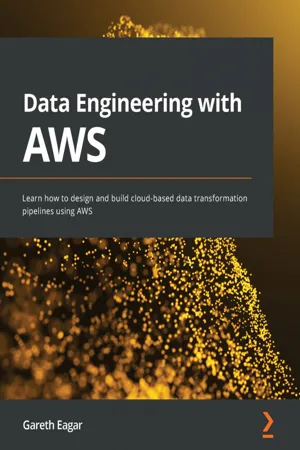
- English
- ePUB (mobile friendly)
- Available on iOS & Android
Data Engineering with AWS
About this book
The missing expert-led manual for the AWS ecosystem — go from foundations to building data engineering pipelines effortlesslyPurchase of the print or Kindle book includes a free eBook in the PDF format.
Key Features
- Learn about common data architectures and modern approaches to generating value from big data
- Explore AWS tools for ingesting, transforming, and consuming data, and for orchestrating pipelines
- Learn how to architect and implement data lakes and data lakehouses for big data analytics from a data lakes expert
Book Description
Written by a Senior Data Architect with over twenty-five years of experience in the business, Data Engineering for AWS is a book whose sole aim is to make you proficient in using the AWS ecosystem. Using a thorough and hands-on approach to data, this book will give aspiring and new data engineers a solid theoretical and practical foundation to succeed with AWS.As you progress, you'll be taken through the services and the skills you need to architect and implement data pipelines on AWS. You'll begin by reviewing important data engineering concepts and some of the core AWS services that form a part of the data engineer's toolkit. You'll then architect a data pipeline, review raw data sources, transform the data, and learn how the transformed data is used by various data consumers. You'll also learn about populating data marts and data warehouses along with how a data lakehouse fits into the picture. Later, you'll be introduced to AWS tools for analyzing data, including those for ad-hoc SQL queries and creating visualizations. In the final chapters, you'll understand how the power of machine learning and artificial intelligence can be used to draw new insights from data.By the end of this AWS book, you'll be able to carry out data engineering tasks and implement a data pipeline on AWS independently.
What you will learn
- Understand data engineering concepts and emerging technologies
- Ingest streaming data with Amazon Kinesis Data Firehose
- Optimize, denormalize, and join datasets with AWS Glue Studio
- Use Amazon S3 events to trigger a Lambda process to transform a file
- Run complex SQL queries on data lake data using Amazon Athena
- Load data into a Redshift data warehouse and run queries
- Create a visualization of your data using Amazon QuickSight
- Extract sentiment data from a dataset using Amazon Comprehend
Who this book is for
This book is for data engineers, data analysts, and data architects who are new to AWS and looking to extend their skills to the AWS cloud. Anyone new to data engineering who wants to learn about the foundational concepts while gaining practical experience with common data engineering services on AWS will also find this book useful.A basic understanding of big data-related topics and Python coding will help you get the most out of this book but it's not a prerequisite. Familiarity with the AWS console and core services will also help you follow along.
]]>
Frequently asked questions
- Essential is ideal for learners and professionals who enjoy exploring a wide range of subjects. Access the Essential Library with 800,000+ trusted titles and best-sellers across business, personal growth, and the humanities. Includes unlimited reading time and Standard Read Aloud voice.
- Complete: Perfect for advanced learners and researchers needing full, unrestricted access. Unlock 1.4M+ books across hundreds of subjects, including academic and specialized titles. The Complete Plan also includes advanced features like Premium Read Aloud and Research Assistant.
Please note we cannot support devices running on iOS 13 and Android 7 or earlier. Learn more about using the app.
Information
Section 1: AWS Data Engineering Concepts and Trends
- Chapter 1, An Introduction to Data Engineering
- Chapter 2, Data Management Architectures for Analytics
- Chapter 3, The AWS Data Engineer’s Toolkit
- Chapter 4, Data Cataloging, Security, and Governance
Chapter 1: An Introduction to Data Engineering
- The rise of big data as a corporate asset
- The challenges of ever-growing datasets
- The role of the data engineer as a big data enabler
- The benefits of the cloud when building big data analytic solutions
- Hands-on - create or access an AWS account for following along with the hands-on activities in this book
Technical requirements
The rise of big data as a corporate asset
- Microsoft
- Apple
- Alphabet (Google)
- Amazon
- Tesla
- They have an effective data analytics and machine learning program that differentiates them from their competitors.
- They are conducting proof of concept projects to evaluate how analytic and machine learning programs can help them achieve a competitive advantage.
- Their leaders are having sleepless nights worrying about how their competitors are using analytics and machine learning programs to achieve a competitive advantage over them.
The challenges of ever-growing datasets
Table of contents
- Data Engineering with AWS
- Contributors
- Preface
- Section 1: AWS Data Engineering Concepts and Trends
- Chapter 1: An Introduction to Data Engineering
- Chapter 2: Data Management Architectures for Analytics
- Chapter 3: The AWS Data Engineer's Toolkit
- Chapter 4: Data Cataloging, Security, and Governance
- Section 2: Architecting and Implementing Data Lakes and Data Lake Houses
- Chapter 5: Architecting Data Engineering Pipelines
- Chapter 6: Ingesting Batch and Streaming Data
- Chapter 7: Transforming Data to Optimize for Analytics
- Chapter 8: Identifying and Enabling Data Consumers
- Chapter 9: Loading Data into a Data Mart
- Chapter 10: Orchestrating the Data Pipeline
- Section 3: The Bigger Picture: Data Analytics, Data Visualization, and Machine Learning
- Chapter 11: Ad Hoc Queries with Amazon Athena
- Chapter 12: Visualizing Data with Amazon QuickSight
- Chapter 13: Enabling Artificial Intelligence and Machine Learning
- Chapter 14: Wrapping Up the First Part of Your Learning Journey
- Other Books You May Enjoy